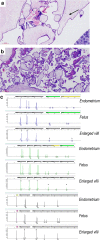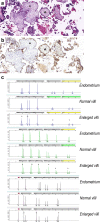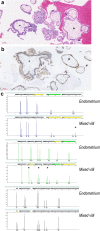Identification of a hydatidiform mole in twin pregnancy following assisted reproduction
- PMID: 31833013
- PMCID: PMC7125262
- DOI: 10.1007/s10815-019-01650-3
Identification of a hydatidiform mole in twin pregnancy following assisted reproduction
Abstract
Purpose: The aim of this study was to identify a co-existing hydatidiform mole (HM) in twin pregnancy from the abnormal mixed-genomic products of conception (POC) after assisted reproduction by histopathological review, evaluation of p57kip2 immunostaining and short tandem repeat genotyping.
Methods: Thirty-seven patients were collected with suspicion for HM by pathological morphology. They had two embryos individually transferred to their uterus after in vitro fertilization and presented two gestational sacs with undeveloped embryos or one sac with an abnormal area by ultrasonography.
Results: Thirty patients were diagnosed as singleton pregnancy, including twenty-two non-molar gestations, six trisomy gestations, one homozygous complete mole and one heterozygous partial mole. Although six patients had ultrasonic imaging of two gestational sacs, the embryonic components in the vacant sac might fade away after transferring. Other seven patients were considered as twin pregnancy by the allelic genotype from two individual conceptions. For the patients with uniform p57kip2 positivity, excessive paternal alleles indicated the potential partial HM in the twin pregnancy. For the patients demonstrated divergent and/or discordant p57kip2 immunostaining, twin pregnancy with co-existing complete HM or mosaic conception were confirmed by genotyping of different villi population respectively. These patients were monitored by serum β-HCG, while one twin pregnancy with complete mole suffered invasive mole and received chemotherapy.
Conclusions: A strategy composed of selective clinicopathological screening, immunohistochemical interpretation and accurate genotyping is recommended for diagnostically challenging mixed-genomic POC of potential twin pregnancy with HM, especially to differentiate a non-molar mosaic conception from a partial mole.
Keywords: Assisted; Hydatidiform mole; Reproduction; Short tandem repeat; Twin pregnancy; p57kip2.
Conflict of interest statement
The authors declare that they have no conflict of interest.
Figures



Similar articles
-
DNA Genotyping of Nonmolar Donor Egg Pregnancies With Abnormal Villous Morphology: Allele Zygosity Patterns Prevent Misinterpretation as Complete Hydatidiform Mole.Int J Gynecol Pathol. 2018 Mar;37(2):191-197. doi: 10.1097/PGP.0000000000000395. Int J Gynecol Pathol. 2018. PMID: 28463912
-
The usefulness of p57(KIP2) immunohistochemical staining and genotyping test in the diagnosis of the hydatidiform mole.Pathol Res Pract. 2011 Aug 15;207(8):498-504. doi: 10.1016/j.prp.2011.06.004. Epub 2011 Jul 20. Pathol Res Pract. 2011. PMID: 21767919
-
[Molecular pathological diagnosis of twin pregnancy with complicated genetical characteristics].Zhonghua Bing Li Xue Za Zhi. 2020 Aug 8;49(8):788-793. doi: 10.3760/cma.j.cn112151-20200106-00013. Zhonghua Bing Li Xue Za Zhi. 2020. PMID: 32746544 Chinese.
-
Genetics of gestational trophoblastic disease.Best Pract Res Clin Obstet Gynaecol. 2021 Jul;74:29-41. doi: 10.1016/j.bpobgyn.2021.01.004. Epub 2021 Feb 2. Best Pract Res Clin Obstet Gynaecol. 2021. PMID: 33685819 Review.
-
Tetraploid partial hydatidiform mole: a case report and review of the literature.Int J Gynecol Pathol. 2012 Jan;31(1):73-9. doi: 10.1097/PGP.0b013e31822555b3. Int J Gynecol Pathol. 2012. PMID: 22123726 Review.
Cited by
-
Twin Gestation with Complete Hydatidiform Mole and Demise of Co-Existing Fetus.Sultan Qaboos Univ Med J. 2022 Aug;22(3):430-431. doi: 10.18295/squmj.9.2021.132. Epub 2022 Aug 25. Sultan Qaboos Univ Med J. 2022. PMID: 36072084 Free PMC article. No abstract available.
-
A nomogram to predict preterm birth in twin pregnancies.Am J Transl Res. 2022 Oct 15;14(10):7119-7127. eCollection 2022. Am J Transl Res. 2022. PMID: 36398206 Free PMC article.
References
-
- Kihara M, Usui H, Tanaka H, Inoue H, Matsui H, Shozu M. Complicating preeclampsia as a predictor of poor survival of the fetus in complete hydatidiform mole coexistent with twin fetus. J Reprod Med. 2012;57:325–328. - PubMed
MeSH terms
Substances
Grants and funding
LinkOut - more resources
Full Text Sources
Medical

